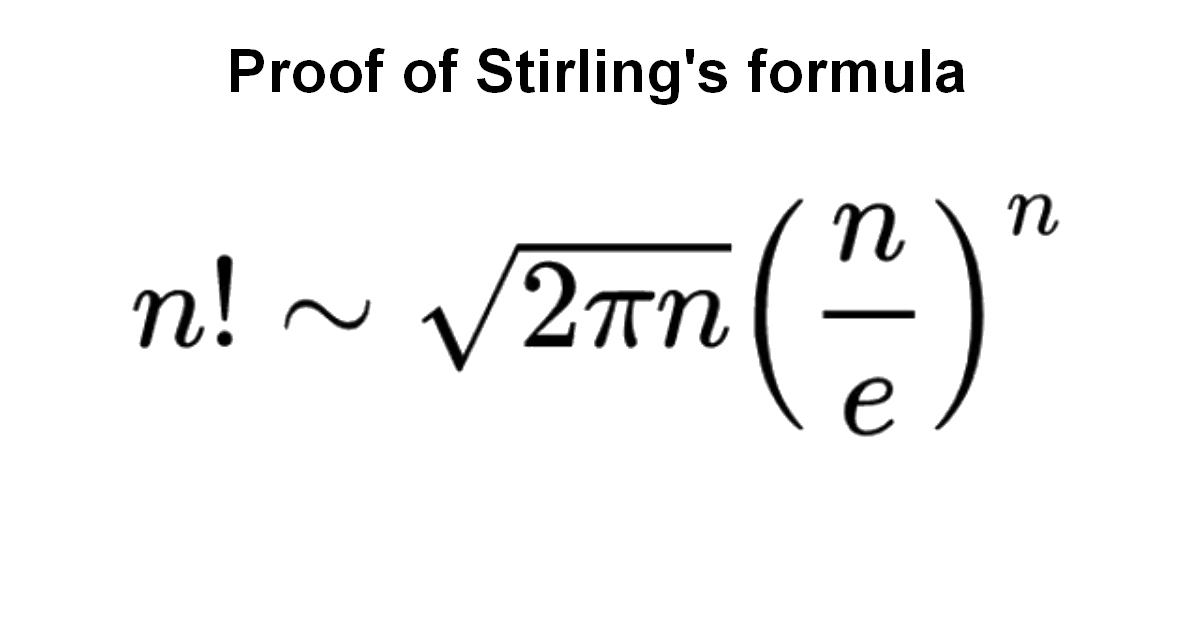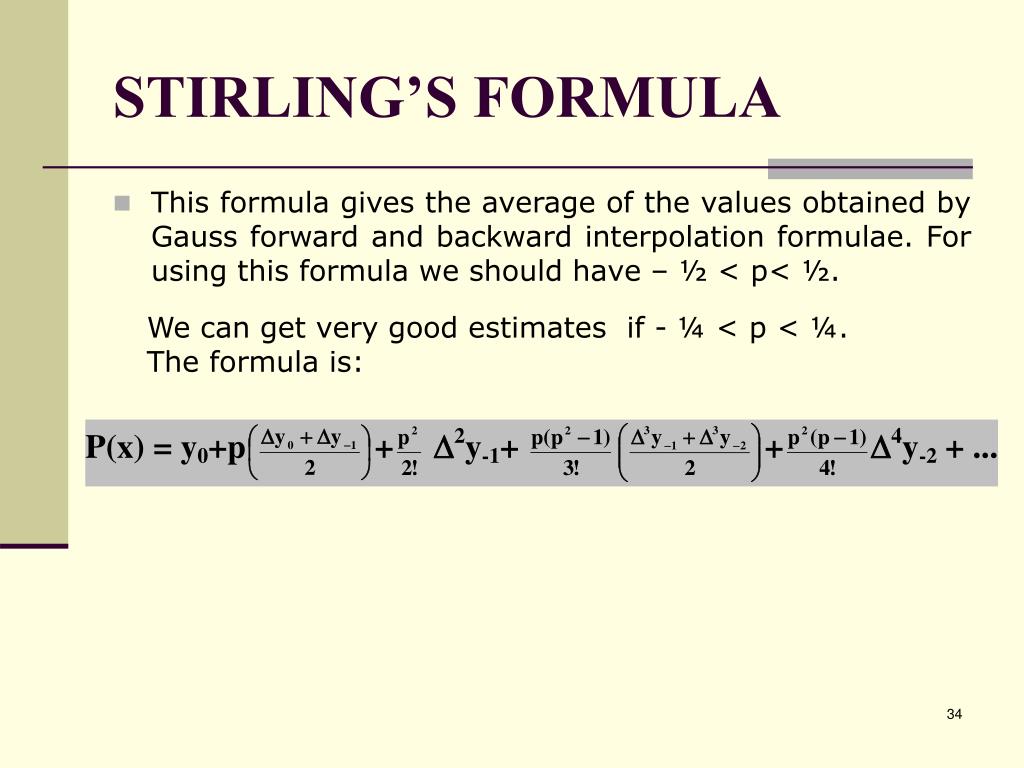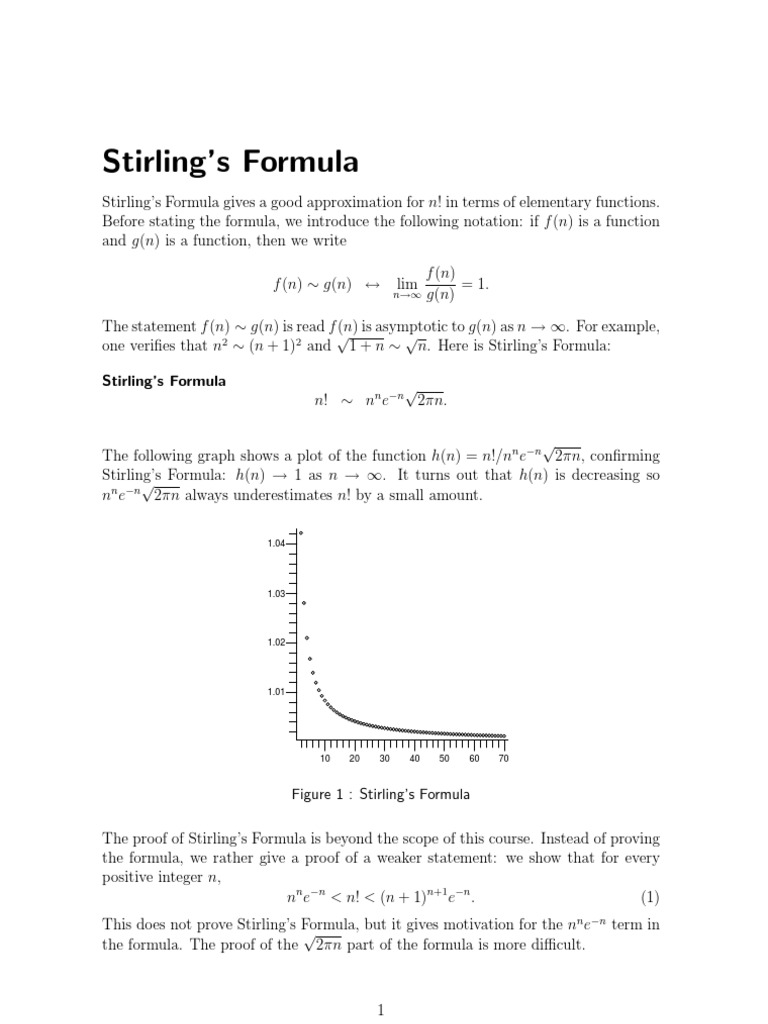Stirling's Approximation for n! [Proof] YouTube

Formule de Stirling Démonstration YouTube
the Bohr-Mollerup Theorem, which gives Euler's limit formula for the gamma func-tion. We then discuss two independent topics. The first is upper and lower bounds on the gamma function, which lead to Stirling's Formula. The second is the Euler- Mascheroni Constant and the digamma function.

PPT 22C19 Discrete Math Sequence and Sums PowerPoint Presentation
Comparison of Stirling's approximation with the factorial. In mathematics, Stirling's approximation (or Stirling's formula) is an asymptotic approximation for factorials.It is a good approximation, leading to accurate results even for small values of .It is named after James Stirling, though a related but less precise result was first stated by Abraham de Moivre.

Stirling's Formula YouTube
Stirling's Formula . stirling.2 . Closed form for n! n. n! ::= 1⋅2⋅3⋅⋅⋅(n-1)⋅n i = i=1. ∏. Turn product into a sum taking logs: ln(n!) = ln( 1·2·3···(n - 1)·n ) = ln 1 + ln 2 + · · · + ln(n - 1) + ln(n) n = 1. ∑. ln(i) i= Albert R Meyer, April 10, 2013 stirling.3 . Integral Method to bound. ln 2 ln 3 ln 4 ln 5.

1 Stirling's formula Download Scientific Diagram
Stirling formula or Stirling approximation is used to finding the approximate value of factorial of a given number ( n! or \(\Gamma \) (n) for n >> ). It was named after James Stirling. Stirling formula is a good approximation formula, it helps in finding the factorial of larger numbers easily and it leads to exacts results for small values of.

Complex Analysis 28 Stirling`s Formula Physics Reference
Proof 2. Consider the sequence dn defined as: dn = ln(n!) − (n + 1 2)lnn + n. From Lemma 2 it is seen that dn is a decreasing sequence . From Lemma 3 it is seen that the sequence : dn − 1 12n . is increasing . In particular: ∀n ∈ N > 0: dn − 1 12n ≥ d1 = 1 12.

Stirling approximation derivation YouTube
Stirling's Formula is a classical formula to compute n! accurately when nis large. We will derive a version of Stirling's formula using complex analysis and residues. Recall the formula for the second logarithmic derivative of the gamma function: d dz 0(z) ( z) = X1 n=0 1 (z+ n)2: Let's start with the partial sum 1 z2 + 1

Solution Proof Stirling formula Art Of Mathematics
Stirling's Formula The goal here is to derive a quantitative version (cf. (5) below) of Stirling's formula n! ˘ p 2ˇn n e n: The proof consists of two steps. The rst step is to show that the limit lim n!1 n! p 2ˇn n e n exists, and the second step is to compute this limit. Clearly log n! = P n m=2 log m. Set f(x) = xlog x xfor x>0. Then.

Stirling's Approximation for n! [Proof] YouTube
Stirling's approximation gives an approximate value for the factorial function or the gamma function for . The approximation can most simply be derived for an integer by approximating the sum over the terms of the factorial with an integral , so that. The equation can also be derived using the integral definition of the factorial , Note that.

Solved 5. Stirling's formula by the method of steepest
The representation (*) was established by J. Stirling (1730). Comments See Gamma-function for the corresponding asymptotic series (Stirling series) and additional references.

PPT Stirling Cycle a n d Engines PowerPoint Presentation, free
For practical computations, Stirling's approximation, which can be obtained from his formula, is more useful: lnn! ≅ nlnn − n, where ln is the natural logarithm. Using existing logarithm tables, this form greatly facilitated the solution of otherwise tedious computations in astronomy and navigation .

Stirling Central Difference Formula YouTube
Stirling's Formula. The factorial function n! n! is approximated by. n! \sim \sqrt {2 \pi n}\left (\frac {n} {e}\right)^n. n! ∼ 2πn(en)n. Furthermore, for any positive integer n n, we have the bounds. \sqrt {2\pi}\ n^ {n+ {\small\frac12}}e^ {-n} \le n! \le e\ n^ {n+ {\small\frac12}}e^ {-n}. 2π nn+21e−n ≤ n! ≤ e nn+21e−n. What is the.

PPT Chapter 3 PowerPoint Presentation, free download ID6448330
Proof of Stirling's Formula. First take the log of n! to get Since the log function is increasing on the interval , we get for . Add the above inequalities, with , we get Though the first integral is improper, it is easy to show that in fact it is convergent. Using the anti- derivative of (being ), we get Next, set We have Easy algebraic.

Stirling Formula Logarithm Functions And Mappings
Stirling formula offers a simple way to compute n!, which for a large positive integer n is a very tedious task to perform. For a long time, double gamma and multiple gamma functions did not come in the limelight, but in the course of time these were used to prove many classical formula, such as the Integral formulas.

Stirling Formula Learn the Stirling Formula
2. the sequence is increasing. and that C > d1 - 1/12 = 1 - 1/12 = 11/12. Taking the exponential of dn, we get. The final step in the proof if to show that . This will be done via Wallis formula (and Wallis integrals). Indeed, recall the limit. since we are dealing with constants, we get in fact . This completes the proof of the Stirling's formula.

Formula Stirling
Learn about the Stirling Formula, which approximates factorials: n! ≈ √(2πn) * (n/e)^n. Useful for large n, simplifying complex calculations in math and science. English . Get Started;. Overview. Test Series. The Stirling formula is an approximation used to estimate the factorial of a large positive integer.

Stirling Approximation A function that approximates factorials. by
This is Stirling's formula. For corrections to the formula, see M. Boas, Mathematical Methods in the Physical Sciences, sections 9-10 and 9-11. You know that. Stirling's approximation gives a rigorous lower bound for n!. a. Use the general ideas presented in the derivation of that lower bound to show that \[ \int_{1}^{n} \ln (x+1) d x.